A Broadwell Retrospective Review in 2020: Is eDRAM Still Worth It?
by Dr. Ian Cutress on November 2, 2020 11:00 AM ESTGaming Tests: Strange Brigade
Strange Brigade is based in 1903’s Egypt, and follows a story which is very similar to that of the Mummy film franchise. This particular third-person shooter is developed by Rebellion Developments which is more widely known for games such as the Sniper Elite and Alien vs Predator series. The game follows the hunt for Seteki the Witch Queen, who has arose once again and the only ‘troop’ who can ultimately stop her. Gameplay is cooperative centric with a wide variety of different levels and many puzzles which need solving by the British colonial Secret Service agents sent to put an end to her reign of barbaric and brutality.
The game supports both the DirectX 12 and Vulkan APIs and houses its own built-in benchmark as an on-rails experience through the game. For quality, the game offers various options up for customization including textures, anti-aliasing, reflections, draw distance and even allows users to enable or disable motion blur, ambient occlusion and tessellation among others. Strange Brigade supports Vulkan and DX12, and so we test on both.
- 720p Low, 1440p Low, 4K Low, 1080p Ultra
The automation for Strange Brigade is one of the easiest in our suite – the settings and quality can be changed by pre-prepared .ini files, and the benchmark is called via the command line. The output includes all the frame time data.

| AnandTech | Low Res Low Qual |
Medium Res Low Qual |
High Res Low Qual |
Medium Res Max Qual |
| Average FPS |  |
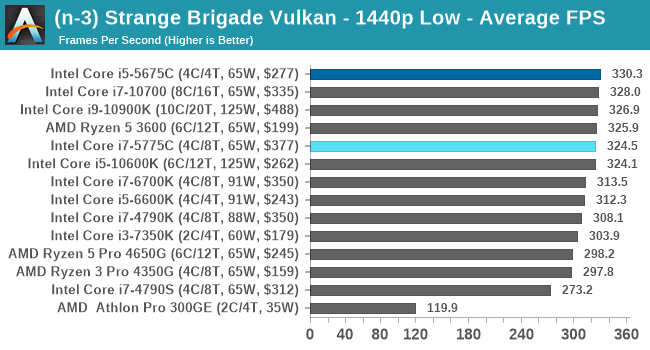 |
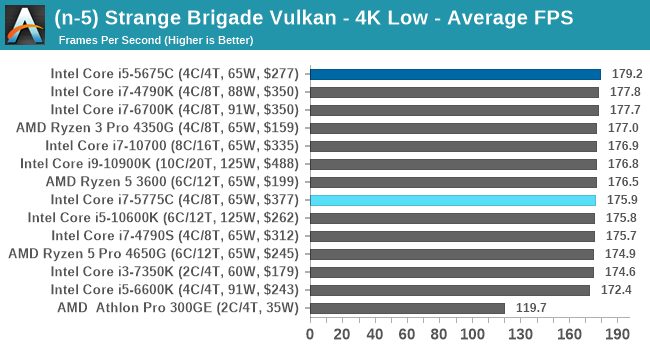 |
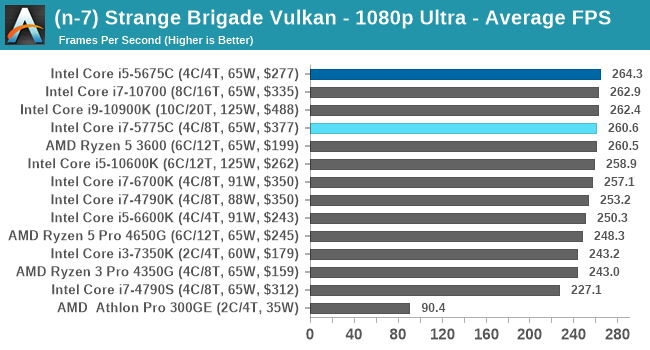 |
| 95th Percentile | 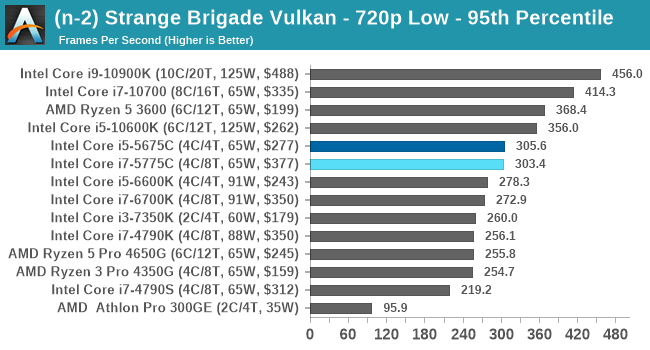 |
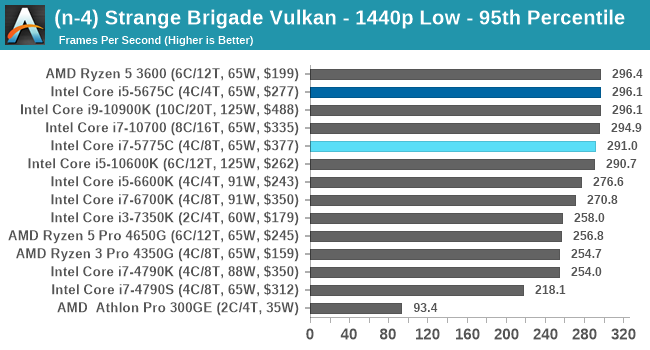 |
 |
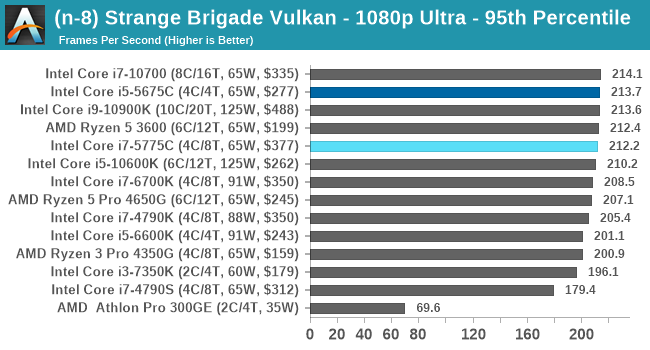 |
All of our benchmark results can also be found in our benchmark engine, Bench.











120 Comments
View All Comments
Leeea - Monday, November 2, 2020 - link
great reviewsadly i7-5775C's are still selling for $100+ on ebay. Not quite worth the upgrade over the i7-4790K, with graphics cards continuing to be by far the largest factor.
But to me it also shows there is no need to jump into the latest and greatest cpu, because these old cpus are still keeping up just fine.
plonk420 - Monday, November 2, 2020 - link
> sadly i7-5775C's are still selling for $100+ on ebayohhhh, that makes me curious as to how they compare to 3100/3300X chips now
Roy2002 - Monday, November 2, 2020 - link
So the conclusion is Optane could play a big role in future?Leeea - Monday, November 2, 2020 - link
no.Optane is slower then normal RAM.
Optane is a faster more limited version of an SSD. Specifically it has RAM like read performance in some areas, while having SSD like write performance in other areas.
Jorgp2 - Monday, November 2, 2020 - link
SSDs are much slower than Optane in writes.The worst case performance for Optane is better than the best performance for an SSD in writes.
FunBunny2 - Monday, November 2, 2020 - link
"The worst case performance for Optane is better than the best performance for an SSD in writes."may haps Optane will optimize when used with code compiled to use only memory-to-memory execution and no hard I/O?
Tomatotech - Monday, November 2, 2020 - link
I would have loved to see Intel embed a couple of gig of Optane on every mobo or in every CPU - at scale it would have been cheap - and we would get the benefits of instant app start, damn fast reboot etc. That would make a bigger difference to the end user experience than 15% on benchmarks. But no, it came out with poorly implemented tiering software, via expensive almost unused add-in cards. Optane had so much mass-market potential, sadly I think it’s screwed now for use outside the datacentre. Intel of all people should know how tiered storage works, why did they screw it up so badly? They even had a shining example in Apple’s Fusion drive to follow (copy) but still messed it up.Jorgp2 - Monday, November 2, 2020 - link
Have you considered asking supermicro for a skylake GT4e review sample?f00f - Monday, November 2, 2020 - link
That's intel's vision of "embedded" DRAM which is only a kind of embedded, because it is on a separate die. If you look for a proper implementation, look at POWER7 processor (2010) with L3 as eDRAM on the same die as cores.jospoortvliet - Wednesday, November 4, 2020 - link
I am a bit surprised amd didn't embed 32 or 64mb memory in the i/o chip... that would probably be relatively easy and affordable.